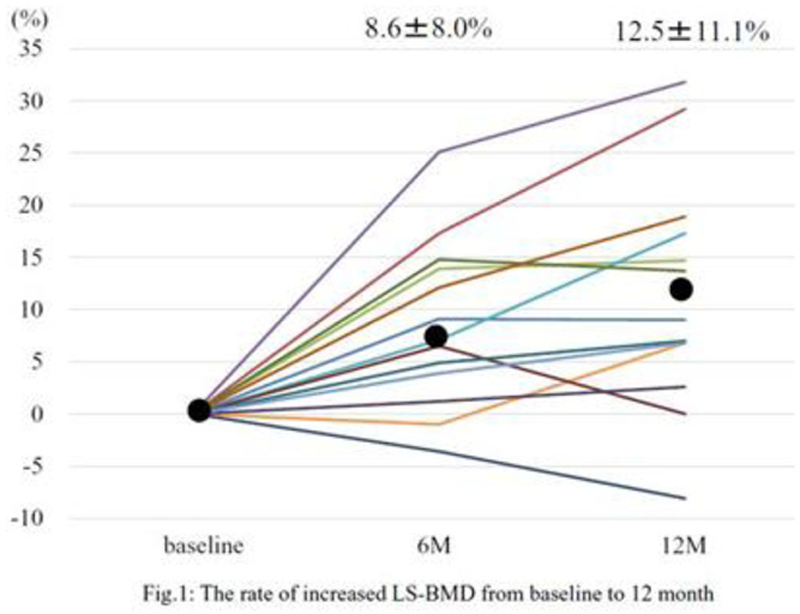

Background: Romosozumab (ROMO), a monoclonal antibody that binds sclerostin, increases bone formation and decreases bone resorption. And although it is a novel therapeutic agent for osteoporosis, which has shown high effects of increasing bone density and inhibiting fragile fracture in overseas clinical trials. However the clinical efficacy for rheumatoid arthritis complicated with osteoporosis (RA-OP) is unknown.
Objectives: To evaluate the clinical efficacy of ROMO in patients with RA-OP for 12 months.
Methods: RA patients diagnosed according to the 2010 ACR/EULAR criteria. All patients met at least one of the following criteria were eligible; a bone mineral density T score of -2.5 or less at the lumber spine or total hip and either one or more moderate or severe vertebral fractures or two or more mild vertebral fractures. All patients were initiated ROMO from between March and December, 2019. The total number of patients was 13 cases. The ROMO dose was 210mg at once every 1 months. In all cases native or activated vitamin D has been used. We reviewed the results for 12 months about the increase and decrease of bone mineral density (BMD) of lumbar spine(LS) and total hip(TH) by DEXA and bone turnover markers, intact n-terminal propeptide type I procollagen(PINP) and tartrate-resistant acid phopshatate form 5b(TRACP-5b).
Results: The gender was all female. The mean age was 73.2 ± 7.6; disease duration was 20.5 ± 16.9 years; the body mass index was 19.7 ± 3.0 and the FRAX was 40.5 ± 16.2. Clinical findings related to RA-OP at baseline were as follows; CRP 1.29 ± 1.66; DAS-CRP 3.43 ± 0.96; HAQ 1.59 ± 0.97 and, bone turnover markers and bone mineral density at baseline were as follows; P1NP 58.1 ± 33.5; TRACP-5b 438 ± 216; LS-BMD and T-score 0.81 ± 0.15 g/cm
2
and -2.63 ± 1.05 and TH-BMD 0.54 ± 0.08 g/cm
2
and -3.22 ± 0.64 g/cm
2
. The rate of increased P1NP from baseline to 1, 3, 6 and 12 months were each 114.3 ± 90.6% at 1 month, 131.6 ± 134.3% at 3 month, 122.6 ± 174.3% at 6 month and 80.4 ± 181.6% at 12 month and decreased TRAC-5b were -10.7 ± 20.8% at 1 month, 7.9 ± 36.9% at 3 month, 25.5 ± 64.6% at 6 month and 32.5 ± 77.0% at 12 month. The rate of increased LS-BMD from baseline to 6 and 12 months were 8.6 ± 8.0%, 12.5 ± 11.1% and TH-BMD were 4.3 ± 5.0%, 6.8 ± 6.9% (
Conclusion: Clinical efficacy of ROMO for RA-OP was extremely effective and has the high potential to be an important option in the treatment of RA-OP.


Disclosure of Interests: None declared